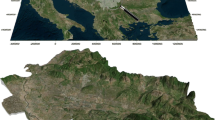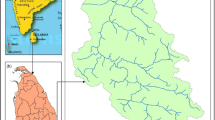Abstract
Soil erosion is a serious environmental problem. An estimation of the expected soil loss by water-caused erosion can be calculated considering the Revised Universal Soil Loss Equation (RUSLE). Geographical Information Systems (GIS) provide different tools to create categorical maps of soil erosion risk which help to study the risk assessment of soil loss. The objective of this study was to develop a GIS open source application (in QGIS), using the RUSLE methodology for estimating erosion rate at the watershed scale (desktop application) and provide the same application via web access (web application). The applications developed allow one to generate all the maps necessary to evaluate the soil erosion risk. Several libraries and algorithms from SEXTANTE were used to develop these applications. These applications were tested in Montalegre municipality (Portugal). The maps involved in RUSLE method—soil erosivity factor, soil erodibility factor, topographic factor, cover management factor, and support practices—were created. The estimated mean value of the soil loss obtained was 220 ton km−2 year−1 ranged from 0.27 to 1283 ton km−2 year−1. The results indicated that most of the study area (80 %) is characterized by very low soil erosion level (<321 ton km−2 year−1) and in 4 % of the studied area the soil erosion was higher than 962 ton km−2 year−1. It was also concluded that areas with high slope values and bare soil are related with high level of erosion and the higher the P and C values, the higher the soil erosion percentage. The RUSLE web and the desktop application are freely available.









Similar content being viewed by others
References
Alexakis, D. D., Hadjimitsis, D. G., & Agapiou, A. (2013). Integrated use of remote sensing, GIS and precipitation data for the assessment of soil erosion rate in the catchment area of “Yialias” in Ciprus. Atmospheric Research, 131, 108–124.
Arekhi, S., Niazi, Y., & Kalteh, A. M. (2012). Soil erosion and sediment yield modelling using RS and GIS techniques: a case study, Iran. Arabian Journal of Geosciences, 5, 285–296.
Bhandari, K. P., Aryal, J., & Darnsawasdi, R. (2015). A geospatial approach to assessing soil erosion in a watershed by integrating socio-economic determinants and the RUSLE model. Natural Hazards, 75, 321–342.
Blanco-Canqui, H., & Rattan, L. (2008). “Soil and water conservation”. Principles of soil conservation and management (pp. 54–80). Dordrecht: Springer.
Bonham-Carter, G. F. (1994). Geographic information systems for geoscientists, modelling with GIS. Computer Method in Geosciences, 13, 152–153.
Cox, C., & Madramootoo, C. (1998). Application of geographic information systems in watershed management planning in St. Lucia. Computers and Electronics in Agriculture, 20, 229–250.
dgTerritório (2015). Direção-Geral do Território. http://www.dgterritorio.pt/cartografia_e_geodesia/cartografia/cartografia_tematica/carta_de_ocupacao_do_solo__cos_/cos__2007/. Accessed Feb 2015.
Django (2015). Django the web framework for perfectionists with deadlines. https://www.djangoproject.com/. Accessed Feb 2015.
Duarte, L, & Teodoro, AC (2015). An easy, accurate and efficient procedure to create Forest Fire Risk Maps using Modeler (SEXTANTE plugin). Journal of Forestry Research (in press).
Duarte, L., Teodoro, A. C., Gonçalves, J. A., Guerner Dias, A. J., & Espinha Marques, J. (2015). A dynamic map application for the assessment of groundwater vulnerability to pollution. Environment and Earth Science, 74(3), 2315–2327.
Fagnano, M., Nazzareno, D., Alberico, I., & Fiorentino, N. (2012). An overview of soil erosion modeling compatible with RUSLE approach. Rendiconti Lincei, 23, 69–80.
FAO-Unesco-Isric. (1988). Soil Map of the World, revised legend. World Soil Resources Report no 60. Rome: FAO.
Flanagan, D. C., & Nearing, M. A. (1995). USDA-water erosion prediction project: hillslope and watershed model documentation. NSERL report no 10. West Lafayette: USDA-ARS National Soil Erosion Research Laboratory.
GDAL (2013). Geospatial Data Abstraction Library. http://www.gdal.org/. Accessed Feb 2015.
GRASS GIS (2013). The world’s leading free GIS software. http://grass.osgeo.org/. Accessed Feb 2015.
Haber, J., Zeilfelder, F., Davydov, O., & Seidel, H. P. (2001). Smooth approximation and rendering of large scattered data sets. In T. Ertl, K. Joy, & A. Varshney (Eds.), Proceedings of IEEE Visualization 2001 (Vol. 571, pp. 341–347). Washington: IEEE Computer Society.
He, C. (2001). Integration of geographic information systems and simulation model for watershed management. Environmental Modelling & Software, 18, 809–813.
Ji, U., Velleux, M., Julien, P. Y., & Hwang, M. (2014). Risk assessment of watershed erosion at Naesung Stream, South Korea. Journal of Environmental Management, 136, 16–26.
Jiang, Z., Su, S., Jing, C., Lin, S., Fei, X., & Wu, J. (2012). Spatiotemporal dynamics of soil erosion risk for Anji County, China. Stochastic Environmental Research and Risk Assessment, 26, 751–763.
Julien, P. Y. (2010). Erosion and sedimentation (p. 1). Cambridge: Cambridge University Press. ISBN 978-0-521-53737-7.
Knijff, V., Jones, R. J., & Montanarella, L. (2000). Soil erosion risk assessment in Europe. Brussels: European Soil Bureau, Space Applications Institute, European Commission, European Communities.
Kumar, S., & Kushwaha, S. P. S. (2013). Modelling soil erosion risk based on RUSLE-3D using GIS in a Shivalik sub-watershed. Journal of Earth System Science, 122(2), 389–398.
Kumar, A., Devi, M., & Deshmukh, B. (2014). Integrated remote sensing and geographic information system based RUSLE modelling for estimation of soil loss in western Himalaya, India. Water Resources Management, 28, 3307–3317.
Lar, R. (1994). Soil erosion research method (2nd ed., p. 352). Ankeny: Soil and water conservation Society.
López-Vicente, M., Navas, A., Gaspar, L., & Machín, J. (2013). Advanced modelling of runoff and soil redistribution for agricultural systems: the SERT model. Agricultural Water Management, 125, 1–12.
Loureiro, N. S., & Coutinho, M. A. (2001). A new procedure to estimate the RUSLE EI30 index, based on monthly rainfall data and applied to the Algarve region, Portugal. Journal of Hydrology, 250, 12–18.
Millward, A. A., & Mersey, J. E. (2001). Conservation strategies for effective land management of protected areas using an erosion prediction information system (EPIS). Journal of Environmental Management, 61, 329–343.
Mitasova, H., Hofierka, J., Zlocha, M., & Iverson, L. R. (1996). Modelling topographic potential for erosion and deposition using GIS. International Journal of Information Systems, 10, 629–641.
Morgan, R. P. C., Quinton, J. N., Smith, R. E., Govers, G., Poesen, J. W. A., Auerswald, K., Chisci, G., Torri, D., & Styczen, M. E. (1998). The European Soil Erosion Model (EUROSEM): a dynamic approach for predicting sediment transport from fields and small catchments. Earth Surface Processes and Landforms, 23, 527–544.
Nearing, M. A., Jetten, V., Baffaut, C., Cerdan, O., Couturier, A., Hernandez, M., Le Bissonnais, Y., Nichols, M. H., Nunes, J. P., Renschler, C. S., Souchère, V., & van Oost, K. (2005). Modeling response of soil erosion and runoff to changes in precipitation and cover. Catena, 61, 131–154.
Nekhay, O., Arriaza, M., & Boerboom, L. (2009). Evaluation of soil erosion risk using Analytic Network Process and GIS: a case study from Spanish mountain olive plantation. Journal of Environmental Management, 90, 3091–3104.
Numpy API (2013). Numpy Reference. http://docs.scipy.org/doc/numpy/reference/. Accessed Feb 2015.
Olaya, V. (2004). A gentle introduction to SAGA GIS, Edition 1.1. Rev. December 9.
Oliveira, V. A., Mello, C. R., Durães, M. F., & Silva, A. M. (2014). Soil erosion vulnerability in the Verde river basin, southern Minas Gerais. Ciencia e Agrotecnologia, 38, 262–269.
Ozsoy, G., & Aksoy, E. (2015). Estimation of soil erosion risk within an important agricultural sub-watershed in Bursa, Turkey, in relation to rapid urbanization. Environmental Monitoring and Assessment, 187(7), 187–419.
Ozsoy, G., Aksoy, E., Dirim, M. S., & Tumsavas, Z. (2012). Determination of soil erosion risk in the Mustafakemalpasa River Basin, Turkey, using the revised universal soil loss equation, geographic information system and remote sensing. Environmental Management, 50, 679–694.
Pan, J., & Wen, Y. (2014). Estimation of soil erosion using RUSLE in Caijiamiao watershed, China. Natural Hazards, 71, 2187–2205.
Pimenta, M. T. (1998). Directrizes para a aplicação da equação universal de perda dos solos em SIG, Factor de Cultura C e Factor de Erodibilidade do Solo K. Lisbon: INAG/DSRH (Sistema Nacional de Informação dos Recursos Hídricos).
PyQt4 API (2013). PyQt class reference. http://pyqt.sourceforge.net/Docs/PyQt4/classes.html. Accessed Feb 2015.
Python (2013). Python programming language. http://python.org/. Accessed Feb 2015.
QGIS (2013). QGIS Project. http://www.qgis.org/. Accessed Feb 2015.
QGIS API (2013). QGIS API Documentation. http://www.qgis.org/api/. Accessed Feb 2015.
Rejani, R., Rao, K. V., Osman, M., Srinivasa Rao, C., Reddy, S., Chary, G. R., Pushpanjali, & Samuel, J. (2016). Spatial and temporal estimation of soil loss for the sustainable management of a wet semi-arid watershed cluster. Environmental Monitoring and Assessment, 188(3), 143.
Renard, K. G., Foster, G. R., Weesies, G. A., McCool, D. K., & Yoder, D. C. (1997). Predicting Soil erosion by water: a guide to conservation planning with the Revised Universal Soil Loss Equation (RUSLE) (Vol. 703, pp. 1–251). Washington: Agriculture Handbook, US Department of Agriculture.
SAGA (2013). System for automated geoscientific analyses. http://www.saga-gis.org/. Accessed Feb 2015.
SNIAmb (2015). Sistema Nacional de Informação de Ambiente. http://sniamb.apambiente.pt/Home/Default.htm. Accessed Feb 2015.
Stallman, P (2007). Why ‘Open Source’ misses the point of free software. GNU Operating System. http://www.gnu.org/philosophy/open-sourcemisses-the-point.html. Accessed Feb 2015.
Teodoro, A. C., & Duarte, L. (2013). Forest Fire risk maps: a GIS open source application—a case study in Norwest of Portugal. International Journal of Geographical Information Science, 27(4), 699–720.
Trabucchi, M., Puente, C., Comin, F. A., Olague, G., & Smith, S. V. (2012). Mapping erosion risk at the basin scale in a Mediterranean environment with opencast coal mines to target restoration actions. Regional Environmental Change, 12, 675–687.
Wischmeier, W. H., & Smith, D. D. (1978). Predicting rainfall erosion losses: a guide to conservation planning with Universal Soil Loss Equation (USLE). Washington: Agriculture Handbook, Department of Agriculture.
Wischmeier, W. H., Johnson, C. B., & Cross, B. V. (1971). A soil erodibility nomograph for farmland and construction sites. Journal of Soil and Water Conservation, 26, 189–193.
Wordofa, G. (2011). Soil erosion modeling using GIS and RUSLE on the Eurajoki watershed Finland. Tampere University of Applied Sciences, Degree Program in Environmental Engineering, Bachelor’s Thesis.
Xu, L., Xu, X., & Meng, X. (2012). Risk assessment of soil erosion in different rainfall scenarios by RUSLE model coupled with Information Diffusion Model: a case study of Bohai Rim, China. Catena, 100, 74–82.
Zhang, H., Yang, Q., Li, R., Liu, Q., Moore, D., He, P., Ritsema, C. J., & Geissen, V. (2013). Extension of a GIS procedure for calculating the RUSLE equation LS factor. Computers & Geosciences, 52, 177–188.
Acknowledgments
The authors would like to thank DGT (Direção Geral do Território) for the data provided, Professor João Pedro Pedroso for the help provided in this work, and professional English reviewer Sofia de Melo Araújo.
Author information
Authors and Affiliations
Corresponding author
Rights and permissions
About this article
Cite this article
Duarte, L., Teodoro, A.C., Gonçalves, J.A. et al. Assessing soil erosion risk using RUSLE through a GIS open source desktop and web application. Environ Monit Assess 188, 351 (2016). https://doi.org/10.1007/s10661-016-5349-5
Received:
Accepted:
Published:
DOI: https://doi.org/10.1007/s10661-016-5349-5




